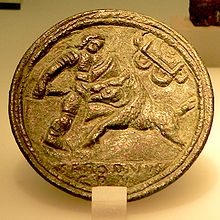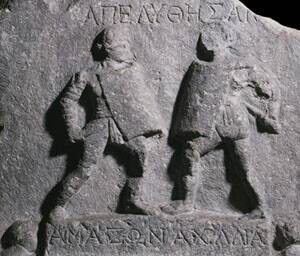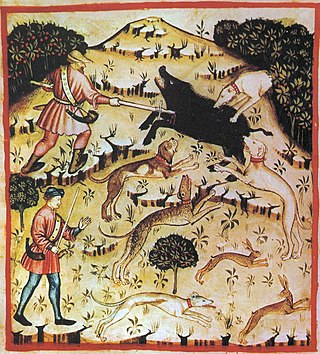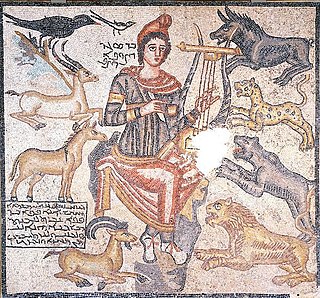
Venatio (Latin : venatio, "hunting", plural venationes) was a type of entertainment in Roman amphitheaters involving the hunting and killing of wild animals.

Venatio (Latin : venatio, "hunting", plural venationes) was a type of entertainment in Roman amphitheaters involving the hunting and killing of wild animals.
Venatio was first introduced by Marcus Fulvius Nobilior, who celebrated his Greek campaign by hosting games where gladiators would fight lions and panthers. [1] He was possibly inspired by Alexander the Great's purported pastime of pitting lions against both men and dogs. [2]
Exotic wild beasts from the far reaches of the Roman Empire were brought to Rome and hunts were held in the morning prior to the afternoon main event of gladiatorial duels. The hunts were held in the Roman Forum, the Saepta, and in the Circus Maximus, though none of these venues offered protection to the crowd from the wild animals on display. Special precautions were taken to prevent the animals from escaping these venues, such as the erection of barriers and the digging of ditches. Very few animals survived these hunts though they did sometimes defeat the "bestiarius", or hunter of wild beast. Thousands of wild animals would be slaughtered in one day. During the Inaugural games of the Flavian Amphitheatre (80), about 9,000 animals were killed. [3]

Not all the animals were ferocious, though most were. Animals that appeared in the venatio included lions, elephants, bears, tigers, [4] deer, cows, wolverines, zebras, ostriches, vultures, weasels, polecats, minks, horses, rhinoceroses, gazelles, giraffes, eagles, falcons, wild goats, parrots, dogs, camels, monkeys, wolves, jackals, foxes, hyenas, leopards, crocodiles, boars, hippopotamuses, [5] and rabbits. [6] Some of these animals were trained, and instead of fighting, performed tricks.
The treatment given to wolves differed from the treatment meted out to other large predators. The Romans generally seem to have refrained from intentionally harming wolves. For instance, they were not displayed in the venationes due to their religious importance to the Romans. [7]
Revered for its ferocity, the lion was extremely popular in venationes and gladiatorial shows. Thus the dictator Caesar used 400 lions (imported primarily from North Africa and Syria) in the Circus, where the inclusion of the foreign animal lent his shows extra panache. Indeed, obtaining the animals from the far-flung corners of the empire was an ostentatious display of wealth and power by the emperor or other patron to the populace, and was also meant to demonstrate Roman power of the whole human and animal world and to show the plebs of Rome exotic animals they might never see otherwise.
During the reign of Augustus Caesar the circus games resulted in the death of 3,500 elephants. [8]
Following the venatio in the order of daily events was the execution of convicted Roman citizens of lower status, the humiliores. Usual forms of execution included burning at the stake, crucifixion, or ad bestias (when the prisoner is left alone in the ring with one or more wild animals).
Roman emperors often sentenced serious criminals — who then became known as bestiarii — to fatal encounters with the beasts in the Colosseum — an ancient "death sentence". [9] These were the lowest social class of participants in the games. [10]

A gladiator was an armed combatant who entertained audiences in the Roman Republic and Roman Empire in violent confrontations with other gladiators, wild animals, and condemned criminals. Some gladiators were volunteers who risked their lives and their legal and social standing by appearing in the arena. Most were despised as slaves, schooled under harsh conditions, socially marginalized, and segregated even in death.

The Circus Maximus is an ancient Roman chariot-racing stadium and mass entertainment venue in Rome, Italy. In the valley between the Aventine and Palatine hills, it was the first and largest stadium in ancient Rome and its later Empire. It measured 621 m (2,037 ft) in length and 118 m (387 ft) in width and could accommodate over 150,000 spectators. In its fully developed form, it became the model for circuses throughout the Roman Empire. The site is now a public park.

The Colosseum is an elliptical amphitheatre in the centre of the city of Rome, Italy, just east of the Roman Forum. It is the largest ancient amphitheatre ever built, and is still the largest standing amphitheatre in the world, despite its age. Construction began under the emperor Vespasian in 72 and was completed in AD 80 under his successor and heir, Titus. Further modifications were made during the reign of Domitian. The three emperors who were patrons of the work are known as the Flavian dynasty, and the amphitheatre was named the Flavian Amphitheatre by later classicists and archaeologists for its association with their family name (Flavius).

A circus is a company of performers who put on diverse entertainment shows that may include clowns, acrobats, trained animals, trapeze acts, musicians, dancers, hoopers, tightrope walkers, jugglers, magicians, ventriloquists, and unicyclists as well as other object manipulation and stunt-oriented artists. The term circus also describes the field of performance, training and community which has followed various formats through its 250-year modern history. Although not the inventor of the medium, Newcastle-under-Lyme born Philip Astley is credited as the father of the modern circus.

A menagerie is a collection of captive animals, frequently exotic, kept for display; or the place where such a collection is kept, a precursor to the modern zoo or zoological garden.

The gladiatrix is the female equivalent of the gladiator of ancient Rome. Like their male counterparts, gladiatrices fought each other, or wild animals, to entertain audiences at various games and festivals. Very little is known about them. They seem to have used much the same equipment as male gladiators, but were heavily outnumbered by them, and were almost certainly considered an exotic rarity by their audiences. They seem to have been introduced during the very Late Republic and early Roman empire, and were officially banned as unseemly from 200 AD onwards. Their existence is known only through a few accounts written by members of Rome's elite, and a very small number of inscriptions.
Among Ancient Romans, bestiarii were those who went into combat with beasts, or were exposed to them. It is conventional to distinguish two categories of bestiarii: the first were those condemned to death via the beasts and the second were those who faced them voluntarily, for pay or glory. The latter are sometimes erroneously called "gladiators"; to their contemporaries, however, the Latin term gladiator referred specifically to one who fought other men. The contemporary term for those who made a career out of participating in arena "hunts" was venatores.

Animals in sport are a specific form of working animals. Many animals, at least in more commercial sports, are highly trained. Two of the most common animals in sport are horses and dogs.

Ultime grida dalla savana, also known as by its English title Savage Man Savage Beast, is a 1975 Italian mondo documentary film co-produced, co-written, co-edited and co-directed by Antonio Climati and Mario Morra. Filmed all around the world, its central theme focuses on hunting and the interaction between man and animal. Like many mondo films, the filmmakers claim to document real, bizarre and violent behavior and customs, although some scenes were actually staged. It is narrated by the Italian actor and popular dubber Giuseppe Rinaldi and the text was written by Italian novelist Alberto Moravia.

The inaugural games were held, on the orders of the Roman Emperor Titus, to celebrate the completion in AD 80 of the Colosseum, then known as the Flavian Amphitheatre.

The Gladiator Mosaic is a famous set of 5 large mosaics of gladiators and venators and two smaller ones. The mosaics are dated to the first half of the 4th century and are now installed in the Salone of the Galleria Borghese in Rome. They were discovered in 1834 on the Borghese estate at Torrenova, on the Via Casilina outside Rome. Prince Francesco Borghese Aldobrandini requested the excavations be completed. It is believed to have decorated a cryptoporticus of an inner peristylum for a large domus. The mosaics were removed from excavations and restored by Gaetano Ruspi and Filippo Scaccia in 1839. These panels reinvigorated the Borghese Collection after it had shrunk following the sale of much of the collection to Napoleon I.

Boar hunting is the practice of hunting wild boar, feral pigs, warthogs, and peccaries. Boar hunting was historically a dangerous exercise due to the tusked animal's ambush tactics as well as its thick hide and dense bones rendering them difficult to kill with premodern weapons.

Ludi were public games held for the benefit and entertainment of the Roman people . Ludi were held in conjunction with, or sometimes as the major feature of, Roman religious festivals, and were also presented as part of the cult of state.

Orpheus mosaics are found throughout the Roman Empire, normally in large Roman villas. The scene normally shown is Orpheus playing his lyre, and attracting birds and animals of many species to gather around him. Orpheus was a popular subject in classical art, and was also used in Early Christian art as a symbol for Christ.

Damnatio ad bestias was a form of Roman capital punishment where the condemned person was killed by wild animals, usually lions or other big cats. This form of execution, which first appeared during the Roman Republic around the 2nd century BC, had been part of a wider class of blood sports called Bestiarii.

Roman amphitheatres are theatres — large, circular or oval open-air venues with raised seating — built by the ancient Romans. They were used for events such as gladiator combats, venationes and executions. About 230 Roman amphitheatres have been found across the area of the Roman Empire. Early amphitheatres date from the Republican period, though they became more monumental during the Imperial era.
Animals had a variety of roles and functions in ancient Greece and Rome. Fish and birds were served as food. Species such as donkeys and horses served as work animals. The military used elephants. It was common to keep animals such as parrots, cats, or dogs as pets. Many animals held important places in the Graeco-Roman religion or culture. For example, owls symbolized wisdom and were associated with Athena. Humans would form close relationships with their animals in antiquity. Philosophers often debated about the nature of animals and humans. Many believed that the fundamental difference was that humans were capable of reason while animals were not. Philosophers such as Porphyry advocated for veganism.

The spectacles in ancient Rome were numerous, open to all citizens and generally free of charge; some of them were distinguished by the grandeur of the stagings and cruelty.